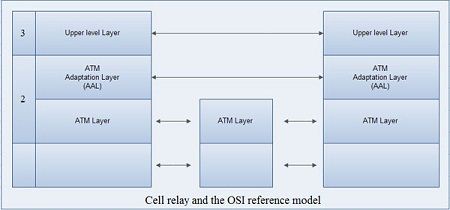Cell relay is data transmission service that uses transmission technology referred to as Asynchronous Transfer Mode (ATM). As the name suggests, the data transmission unit is a fixed length of data known as a cell. High-speed transmission compared to other services like frame relay is possible with the cell relay method. The cell relay is considered by most to be the transport service of the future.
Advantages
- High-speed Transmission The purpose of ATM is to provide high speed and low-delay switching networks to support any type of user traffic, such as voice, data or video applications.
- Multiplexing Transmission As in X.25 networks and frame relay, multiple channels can be set within one physical line and communication is possible with multiple parties simultaneously. ATM segments and multiplexes use traffic into small, fixed length units called cells to reduce and control delay. ATM can support different speeds, traffic types and quality of service matched to applications.
Disadvantages
- Cell Discarding Occurs with Congestion When congestion occurs in the network, the cells (data) within the network are discarded and retransmission control cannot be carried out within the network. The user must be responsible for carrying out retransmission control with other party. ATM provides no error detection operations on users payload inside the cell. It provides no retransmission services, and few operations are performed on the small header. The purpose of this approach is to implement a network fast enough to support multi-megabit transfer rates.
- High Cost As the technology is new and not commercially available; standards are still in development stage.
Cell Relay and the OSI Reference Model
The cell relay protocol corresponds to first two layer of OSI reference model. The part that corresponds to second layer, that is, data link layer is referred as ATM layer. However, ATM layer does not have all functions of data link layer. Therefore, a protocol referred as the ATM Adaptation Layer (AAL) is prescribed above the data link layer AAL is user defined and is not mandatory for cell relay usage.

 Dinesh Thakur holds an B.C.A, MCDBA, MCSD certifications. Dinesh authors the hugely popular
Dinesh Thakur holds an B.C.A, MCDBA, MCSD certifications. Dinesh authors the hugely popular